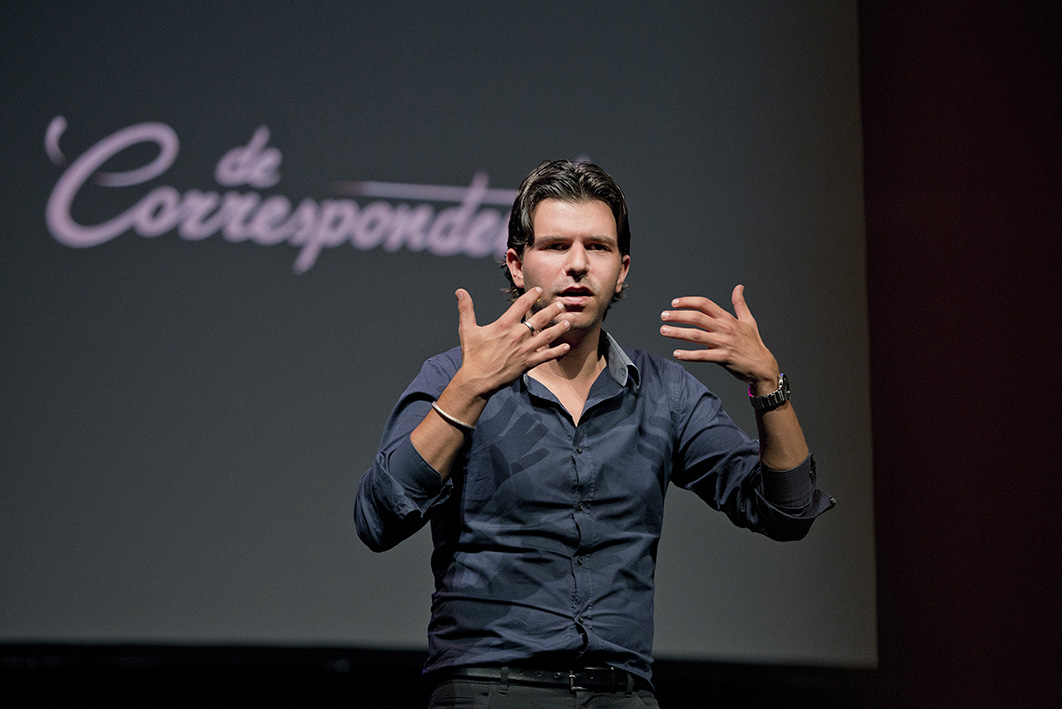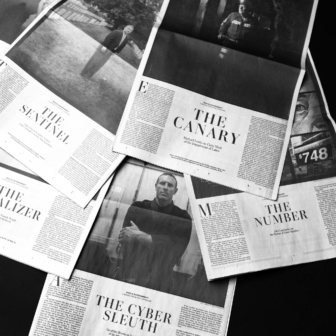But I’m stubborn as those garbage bags
that Time cannot decay,
I’m junk but I’m still holding up
this little wild bouquet:
Democracy is coming to the USA.
— Leonard Cohen
Almost a decade ago, Princeton’s professor of communications and public affairs Paul Starr wrote an essay in the New Republic entitled “Goodbye to the Age of Newspapers (Hello to a New Era of Corruption).” As elegantly and exhaustively as Starr laid out the evidence, his thesis was, in essence, simple. Less advertising in newspapers means fewer journalists and fewer journalists means more corruption and less democracy. So the question Starr posed was whether news — on paper or on screen — would continue to come in anything like the quantity and quality to which we were accustomed. And what would be the consequences if it didn’t?
Starr’s jeremiad wasn’t the only one going around. The collision of the cyclical and the structural — the global financial crisis and the exodus of advertisers to search and social — made it clear that the fourth estate was in trouble. But in the dawn of the Obama administration, a new era of corruption was only an abstract idea, invisible and intangible. It had not yet assumed corpulent shape, clothed itself in leathery orange skin and besmirched everything and everyone it encountered. Even Starr was not so bold as to claim that the new era of which he spoke could be upon us so soon. That would have sounded unbalanced, like predicting Donald Trump would be the next president.
Now news publishers in the United States earn less than 40 per cent of the $50 billion they made selling advertising space in 2004, and the inexorable shift of advertising away from journalism has killed 3000 jobs in Australia. Meanwhile, the start-ups that came into being not long before Starr wrote his article in 2009 are struggling against the Google–Facebook duopoly. HuffPost is shedding 560 jobs; BuzzFeed is laying off staff too; and Mashable sold for less than its 2017 revenue after its value plummeted 80 per cent in two years.
All this has been accompanied by a pronounced shift in the political discourse: less civility, more irrationality, more xenophobia, more authoritarianism and — at least in the case of the executive branch of the US government — more corruption. So can we conclude Starr was right? Has it turned out that the decline of a chance arrangement in which advertisers subsidised news consumption (“where Wal-Mart was willing to subsidize the Baghdad bureau,” as Clay Shirky once so pithily put it) means that our democracy has been fundamentally, perhaps irretrievably, damaged?
The answer to that question depends on at least two further questions. How deep are we, as readers, prepared to dig into our pockets to make up for the income advertisers have taken elsewhere? And, in turn, how much can journalism change in ways that will increase its value to us, thus making us more likely to pay up?
These are questions that publishers and editors around the globe have inscribed firmly within the urgent and important quadrant. When Katharine Viner, editor-in-chief of the Guardian, disclosed in November that her paper now earns more revenue from readers than advertisers, she commented, “We are inviting our readers to be part of a community, whether that means reading and listening to and watching and sharing our work, or responding to it, or by sending us anonymous information or participating in a reporting project.” And she approvingly quoted the director of the Center for Civic Media at MIT, Ethan Zuckerman, who wrote, “If news organisations can help make citizens feel powerful, like they can make effective civic change, they’ll develop a strength and loyalty they’ve not felt in years.”
The Guardian’s entry into the era of majority reader revenue follows that of the New York Times, which is similarly focused on adapting to the new economics of news. “We are not trying to maximise clicks and sell low-margin advertising against them,” the Times declared in its 2020 Report. “We believe that the more sound business strategy for the Times is to provide journalism so strong that several million people around the world are willing to pay for it.”
There may only be room for one New York Times in the global media environment, but it isn’t only international titles that are pursuing reader revenue to maintain commercial viability. Take the French online investigative journal Mediapart, founded in 2008 by Edwy Plenel, the former editor-in-chief of Le Monde, which now has in excess of 130,000 subscribers; or the just-launched Swiss publication Republik, which has garnered over 15,000 subscribers in its first weeks; or sites like El Diario in Spain, The Wire in Delhi and Civil Beats in Honolulu, all recently profiled by the Guardian; or City Bureau, a community news organisation based in Chicago. All are built around revenue that comes directly from readers, mostly through monthly or annual subscriptions.
But perhaps no publication has embraced the new commercial realities — as though they are an opportunity as much as a crisis — like the Dutch site De Correspondent. Founded in 2013 by two successful young journalists, Rob Wijnberg and Ernst-Jan Pfauth, De Correspondent bills itself as “the antidote to the daily news grind.” Launched with an eight-day crowdfunding campaign that raised a million euros, it now boasts 60,000 members who pay around US$63 a year and sustain a full-time staff of twenty-one journalists and seventy-five freelancers. On this foundation, it is set to launch an English-language edition, the Correspondent, in the United States. De Correspondent illustrates how journalism is changing as publishers focus on reader revenue with ever-increasing intensity. In fact, it exemplifies how readers are becoming something different — members.
Early last year, De Correspondent’s climate and energy reporter, Jelmer Mommers, revealed how Royal Dutch Shell’s understanding of the reality of climate change extended back decades. As “Climate of Concern,” a video produced by Shell in 1991, explained, “Global warming is not yet certain, but many think that to wait for final proof would be irresponsible. Action now is seen as the only safe insurance.” Mommers’s story asked what it means when one of the world’s most powerful organisations understands its activities are harmful to life as we know it and yet puts its foot on the accelerator.
The scoop began with an email to De Correspondent’s members. Mommers asked, “What’s the one thing you’d most like to ask someone who works for Shell?” After sharing the most thought-provoking responses, Mommers followed up with a call-out via readers: “Dear Shell Employees: Let’s Talk.” As that invitation elicited leads, he shared his emerging findings with members, engendering a process that culminated in a Shell employee’s handing over a cache of documents revealing that the company has long understood what its business is doing to the planet.
The idea of introducing a story to members before it is written is De Correspondent’s most important innovation. As editor-in-chief Rob Wijnberg explained to Radio National’s Phillip Adams, “I tell my correspondents basically 50 per cent of your job is interacting with your readers, having conversations with them and getting them to contribute what they know to your journalism.” To write about refugee experiences in the Netherlands, Dick Wittenberg and Greta Riemersma asked members to conduct monthly interviews with asylum seekers. Three hundred members connected with people who had recently arrived in the Netherlands, and Wittenberg and Riemersma sent out monthly questionnaires and then synthesised responses into ongoing reportage. “By doing this we get better-informed stories because we have more sources from a wider range of people,” says Ernst-Jan Pfauth. “It’s not just opinion-makers or spokespersons, we get people from the floor.”
Even more interesting, perhaps, are the motivations of members who contribute to stories. One member, a Dutch civil servant, says, “I want Maurits [Martijn, the technology and surveillance correspondent] to write accurately and deeply on technology-related subjects. I know that my knowledge is scarce, and that it makes a big difference if he can access it through me.” Another said, “I hate it when my subject, chemistry, is misunderstood by journalists and things are incorrectly explained in a newspaper article.” Yet another revealed, “I used to work as fisheries specialist for the World Bank, and worked in forty-plus countries. That experience is quite rare. De Correspondent published a few articles about fisheries, and I made some comments. [Journalist] Tamar Stelling liked and highlighted my comments, and — one of the nice activities of De Correspondent — actively requested my input for new articles.”
In these cases, belonging to De Correspondent provides members with an avenue through which they can share their expertise and experiences in a meaningful and influential way, contributing to a larger picture that helps inform public understanding. These are people who used to yell at the TV; now they can do something much more constructive with their insights.
Do we need to recalibrate how we think about “paying for news” accordingly? In the instances above, membership did not grant an opportunity to receive knowledge but to share it. “We believe people don’t become members for “access to the content,” Ernst-Jan Pfauth told media analyst Ken Doctor. “They become members because they want to be part of a movement [or] community.” Maybe it’s a case of both/and: payment is surely still motivated by desire for access, but payment also looks a lot like the membership fee for a political party or union: the price of entry to participate in a collective endeavour. The most distinctive Australian example of member-driven journalism may be Michael West’s investigations of multinational tax evasion funded by GetUp! members. In this case, donations appear to be motivated by the desire for corporate offenders to be publicly named and shamed, as much as by access to the content itself. Now, the Guardian is inviting readers to fund its environmental journalism with the appeal, “help us to move these issues up the public agenda and challenge governments to do more.” In a matter of days, it has raised more than $100,000.
In one sense, De Correspondent’s innovations are minor. Wijnberg and Pfauth no more devised reader engagement or the perennial call to “send us your tips” than they invented comments. What they have done is transform these staples of the digital era from add-ons into core elements of their publication. But can a growth in reader revenue motivated by new models of membership like De Correspondent’s and the Guardian’s (or GetUp!’s incursion into journalism) sustain a robust fourth estate — one that can stave off Starr’s new era of corruption?
When Wijnberg and Pfauth revealed that they would launch a US version of their publication, they also announced a venture called the Membership Puzzle Project — a collaboration with New York University journalism professor, Twitter sage and author of the PressThink blog, Jay Rosen. Its aim is to capture and share the current state of knowledge about what it means to be a member of a news site.
On one level, the project can be read as a humble acknowledgement by the Dutchmen of the inevitable challenges they will face on the other side of the Atlantic. For the Correspondent to eventually achieve the same kind of membership levels as its Dutch parent, proportional to its market, it would need to sign up over a million members. That sounds intimidating. But that’s the kind of growth in paying readers that the industry’s bigger players are pursuing. So the Membership Puzzle Project can also be seen as a recognition that De Correspondent’s journey is part of a much larger story of industry-wide transformation. In one way or another, everyone is trying to solve it.
It’s possible that a solution won’t be found, and a debilitated fourth estate will be unable to constrain a new era of corruption and authoritarianism. But in De Correspondent we can also detect the fragrant possibility that journalism, in responding to the new commercial realities, will revitalise itself and the public sphere, thereby enriching democratic life.
Advertising’s diminishing role in financing journalism could even turn out to be a blessing. When Wijnberg and Pfauth resolved not to carry any advertising in De Correspondent it was more than just an acceptance of a fait accompli, it was a matter of principle: “Our business model is selling quality journalism to members, not selling our members out to advertisers.”
To think about the tension between those two activities, consider the resignation in 2015 of Peter Oborne, chief political editor of Britain’s Telegraph. The year before, Oborne had written about the apparently arbitrary decision of Europe’s largest bank, HSBC, to close the accounts of a number of prominent British Muslims. “It’s like having your water cut off,” a victim told Oborne. Disturbed to find his article hadn’t been published, Oborne made inquiries and was told there was a legal problem. But when he attempted to follow this up with the Telegraph’s lawyers it turned out that they were unaware there was any issue. Eventually, an executive confessed to Oborne, “there is a bit of an issue” with HSBC: namely, it was a very large advertiser with the paper. As Oborne dug deeper he discovered that the soft coverage of the bank formed part of a larger pattern, and HSBC wasn’t the only powerful advertiser that had enjoyed a very nice run.
In Advertising and a Democratic Press, Ed Baker showed that “the likelihood of a magazine’s publishing an article about smoking’s ill effects decreased as the proportion of its revenue that came from cigarette advertising increased.” Baker pointed out that the New Republic — the magazine for whom Paul Starr wrote his essay on a new era of corruption — once dropped an article criticising tobacco companies that had already been typeset. The editor candidly explained that the decision reflected “the relative size of the account.” The interests of readers, who might have wanted to learn what the article had to say, had to be balanced against the interests of the advertiser. After all, the readers weren’t the major customer. They were the major product.
Wijnberg and Pfauth have decided to serve only one master. As they told Jay Rosen, at De Correspondent they do “not have to think about target groups or tailor its content to please, for instance, well-heeled readers between the ages of twenty-five and forty.” And because merely capturing (and onselling) attention is not the end goal, there is no longer the same incentive to pump out clickbait or concede that “if it bleeds it leads.” Persuading people to pay a monthly or annual membership fee requires fulfilment of a much longer-term value proposition. So the pursuit of reader revenue is conducive to De Correspondent’s aspiration to elevate the structural over the sensational and to be, as it claims, an “antidote to the daily news grind.”
Wijnberg and Pfauth’s decision to put all their eggs in the membership basket might be an admirable one, but it has also become a lot easier to stick to your principles in this regard. Because there is nowhere near as much advertising money sloshing around, competitors who still enjoy that revenue stream don’t have anything like the price–marketing–quality edge that they once did. And because reader revenue — and therefore reader loyalty and trust — are the name of the game, the compromises involved in turning the audience into a product (going easy on big tobacco or big finance, for example) could be more costly than ever. All of which is to say that De Correspondent is a symptom of a broader structural change; it isn’t a random weather event but a reflection of a changing climate.
But there’s a hitch. The same structural changes could also accelerate media fragmentation. As Ethan Zuckerman observes, “the rise of large-circulation newspapers and broadcast media, which needed to avoid alienating large swaths of the population to maintain fiscal viability, led us into a long age where partisan journalism was less common. Even as cable news made partisan news viable again, broadcast news networks and major newspapers maintained aspirations of fairness and balance, attempting to serve the broader public.” Fairness and balance provide their own justification, but journalistic objectivity also made commercial sense when the news industry was all about selling eyeballs to advertisers. Overtly partisan content risked alienating half your potential audience.
Now, the commercial objective is to offer those who might be willing to pay, the core audience, content they value very highly. If that antagonises casual visitors, so be it. This creates an incentive to tap into the core audience’s deepest values and commitments by portraying the world from a distinct position on the political spectrum.
Paul Starr viewed the balkanisation of the media as regrettable because it exacerbates ideological polarisation. Like his anxiety about a new era of corruption, it’s a concern that seems as pertinent as ever. But, as Zuckerman points out, “it’s important to consider that people seek out ideological[ly] compatible media not just out of intellectual laziness, but out of a sense of efficacy.” For example, Zuckerman writes, “if you are a committed Black Lives Matter supporter working on strategies for citizen review of the police, it’s exhausting to be caught in endless debates over whether racism in America is over.”
In its journalism, De Correspondent aims to advance “solutions — and ways to be part of those solutions.” It sees its mission as not just reflecting society but getting it moving in the right direction. Indeed it is unapologetic about being “explicitly subjective.” Objective journalism, Wijnberg argues, is “a misleading and dangerous illusion.” Misleading and dangerous? It’s helpful to consider a concrete example.
One of the hallmarks of the journalism Wijnberg is criticising is the “he said, she said” format. As Jay Rosen says, “No real attempt is made to assess clashing truth claims in the story, even though they are in some sense the reason for the story.” As a paradigmatic case of “he said, she said” reporting, Rosen cites a 2009 New York Times article, “Ex-Chairman of AIG Says Bailout Has Failed,” in which claims (made by former AIG CEO Maurice Greenberg) and counter-claims (made by his former company) are presented. The fact of the matter, says Rosen, was that the claimant had zero credibility and his claims were spurious and self-serving. If pertinent information — which in many cases had already been reported elsewhere in the Times — had not been omitted, that would have been clear to readers. Instead, claim and counter-claim were presented as equally plausible, because to adduce the incriminating evidence and offer an adjudication would have amounted to dropping the guise of neutrality. “The Times’s story,” wrote Rosen, offers “no analysis and forces readers — 95 per cent of whom know little or nothing about Greenberg’s tenure at AIG — to try to guess who’s right. Which is why these stories are so frustrating: we’re left helpless by them.”
The “we report, you decide” ethos implies the humble journalist is the mere servant of the reader. But the pose of deference is disingenuous. If the journalist refrains from offering a verdict, who is the reader to be so bold? After all, the journalist typically stands at greater proximity to the events concerned and is likely able to devote more time and expertise to their interpretation. In the result, as Rosen’s example makes clear, we are often implicitly invited to throw our arms up and conclude that they’re all as bad as each other.
If newspaper coverage of financial institutions is not always influenced by advertising revenue in the manner of the Telegraph’s coverage of HSBC, the Times example suggests a more subtle but more pervasive effect. The pursuit of large non-partisan audiences (the kind advertisers tend to want to buy) incentivises false balance.
Consider, by way of contrast, two articles published in De Correspondent. The first, “I’m Changing Banks This Week. How About You?” presents the case for investing ethically, as well as guidance about how to do it. Six thousand De Correspondent members moved their money in response to the report. In a similar vein, the second piece, “This Week, We’re Taking Steps Each Day Towards Better Privacy. Are You In?” set out how readers can protect their online security, and also provides tools to help members spread the word.
This kind of journalism will only persuade intelligent readers if the evidence exists and is handled fairly. But it offers readers something that is absent from “he said, she said” reporting: the benefit of the journalist’s considered judgement. And there is another, deeper difference. In calling us to act, articles in De Correspondent position the audience as potential participants, capable of walking on to the stage where the drama is unfolding. If that’s the result of the new imperative to appeal to paying members, it doesn’t sound like such a bad thing. Especially when the pursuit of large non-partisan audiences can result in journalism that positions us as passive observers of public life. For when we vicariously experience public events through journalists who want to establish that they have “no skin in the game,” we are invited to view public controversies with similar detachment — as though they are ultimately a matter for others, elsewhere.
In lamenting the decline of advertising-funded media, Paul Starr looked back nostalgically to the days when even the politically apathetic couldn’t escape some hard news. “Entertainment-oriented TV viewers… learned about the world because they had no alternative except to sit through the national network news, [and] many people who… bought a paper for the sports, the recipes, the comics, or the crossword puzzle… nonetheless learned something about the wider world because they [were] likely at least to scan the front page.”
This accidental paternalism, in which the apolitical class is forced to consume politics for its own good, is one way to increase civic engagement. Another approach is to provide the means through which people, by acting together, can make a registerable impact on public life (like contributing knowledge to a story, investing ethically en masse, or pooling funds to back journalism that exposes tax cheats and raises environmental awareness). Then the news might be less likely to leave us feeling powerless, and less ready to avert our gaze from things that seem beyond our control.
The Correspondent may fail to prosper in the United States, but in many ways its prospects look good. Its record of accomplishment in Europe, its endorsement by serious players like Jay Rosen, and its success in putting itself at the centre of the conversation about the future of journalism are all important. But the way the platform establishes a creative tension between the correspondent and the crowd, the professional and the amateur, feels like the internet growing up. Above all, De Correspondent looks like it is made for the times, an era in which loyal and committed members will be the key to commercial success. Either way, it has already helped us view the newspaper crisis — and imagine our future — differently. •




